Harrison County Iowa
Page
design by Judy Wallis White
![]()
| Information on these pages was taken form Bicentennial History Little Sioux Township, a book compiled by the citizens of Little Sioux for the towns Bi-Centennial project. This is a very nice book, complete with pictures and family histories. I have included as many as space allows. Little Sioux will always be dear to my heart as it was the place of my birth. | |
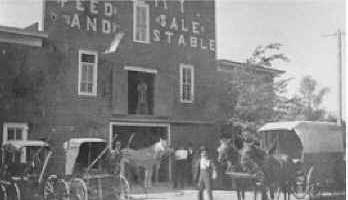 |
The history of Little Sioux is the story of the migration of peoples westward during the mid-nineteenth century, before and after the Civil War. The first movement included the Mormons and land-seekers to the area. A second movement from the west occurred around the 1890's when drought forced settlers out of the Great Plains. Families came here and remained for one generation, their children moving on to greater |
|
opportunities. Some
descendants remained, usually ones of land owning families. Little
Sioux's best years were those following the Civil War until the
first decade of the 20th Century. Movement was restricted because of poor roads and lack of private transportation. Farm labors were a necessity, business in town prospered, social life was centered in homes, fraternal orders, church groups and local activities. The 1900's gradually brought automobiles, good roads, mechanized farms. Little Sioux was to small to match job opportunities and other attractions offered by cities, so the town suffered loss of business and people. |
|

| Little
Sioux's main center of industry, at one time, was the saw-mill and
grist-mill owned and operated by Scofield and Sons. Cottonwood lumber was fairly plentiful and lumber and flour trade drew patronage from long distances. Mother Scofield (Olive Hathaway) was the leader in all social affairs At one time, it seemed the mill was the hub around which the town revolved. when lumber became scarce and the dam went out at the mill due to floods, the mill quit doing business. It caused quite a backslide to the town and it took some time to recover. |
|
|
|
Dr. Blakeman |
|
Little Sioux Post Office
The post office was established in Little Sioux July1, 1857 with Silas W.
Condit as postmaster. There were numerous post masters.
Monette Fox became postmaster in 1936 and held that position for 33 years.
|
|
| salary was $600. The number 2 route was also established under Mr. Reynolds in 1908 with Reginald Conrad as carrier. The postmaster accompanied the carrier on his first trip, the route was only 18 miles long, but was wholly on the Missouri bottom. The gumbo was so heavy and bad that they had to stop every few feet to poket he mudout of the wheels. The wheels would load up with the gumbo and slide, then the mud would fall off from one side of a wheel and it would turn with a chug. Both soles were torn from the postmaster's shoes. The men were unable to complete the full route and returned to the office about nine p.m. Mr. Conrad went back to the route, got stuck in the mud and did not get in until two o'clock the next morning. | |
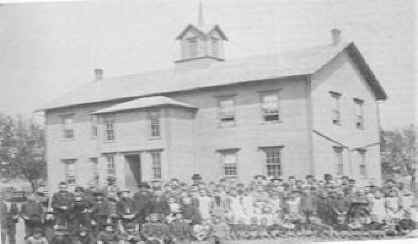
Little Sioux School 1885
For a list of students in this picture click
Here.
|
In 1856-57, because of the increasing number of children in Little Sioux,
the interest in education grew. Because no taxes were levied
for school purposes it was necessary to obtain contributions. In the
summer of 1857 the first school in Little Sioux township was taught by
Miss Mary Gleason in her father's house. The first public school in Little Sioux village was a log building 14 by 20 feet, built during the winter of 1857-58. Parents and others who realized the necessity of having a schoolhouse, hauled logs for construction. The building also served as a meeting place for religious services, programs and old time dances. The first graduating class in the new two story brick building was in 1900. Picture below. |
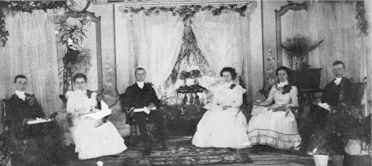
1900 Graduating Class
From left to right: Earl Lanyon, Leona
Hope, William Reynolds, Alta Seymour, Florence Guyton, James Murray
For a list of Little Sioux Graduates 1900 through 1961, click Here
|
|
The play Uncle Tom's Cabin as we know it was given first at Troy, New York, in 1852. The drama grew into such an industry that it came to be a separate brand of show business with a group of specialists who did nothing else. Terry's Uncle Tom's cabin company one of the largest and |
|
oldest of these shows, had it's headquarters in Little
Sioux for thirty-five years. The first Uncle Tom's Cabin show from Little Sioux traveled by wagons and horses. George Setchell was the boss horseman and his son was boss canvassman. At that time the show had two hundred horses. during the second summer the troupe was stranded in the Ozarks, but the residents of Little Sioux rallied to the rescue, salvaging the property and sending the show on to a successful season. they then toured the Dakotas, Minnesota and Iowa for 10 years. |
|
|
|
|
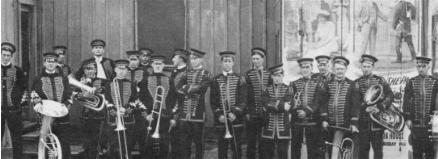
Uncle
Tom's Cabin Band
|
Little Sioux Homecoming |
|
|
In August of 1919, a group
of women met at Amy Kerr's home to plan some way to honor the returning
soldiers from World War I. Mrs. Laura Terry was chosen president of
the group; Sarah Perkins Murray, secretary and Helen Terry (Enevoldsen)
treasurer. As a name for the event, Homecoming was suggested by Mrs. A.J. Boylen, wife of the Superintendent of Schools. This was selected as the official name. |
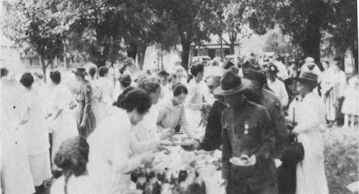 |
|
To raise money for the
affair, donations were solicited and a raspberry social was held, the
group serving raspberries with cream and sugar, coffee and cake.
Today they still hold ice cream socials to raise money for homecoming. The parade was led by Jesse Breeling, dressed as Uncle Sam, wearing a stovepipe hat the had been worn in an election by Mike Murray, Sr. when Grover Cleveland was elected president. Laura Terry made the red and white striped trousers and Amy Kerr furnished the long-tailed blue coat that belonged to her father. Jess being six feet four inches tall made a very imposing figure. Thus Homecoming was begun, to become a yearly event, held the latter part of August. The theme of Homecoming remains the same. Those who have left Little Sioux come back home to meet old friends; those who have remained here greet them for a happy time filled with reminiscence. |
|
Birth of the Hustler
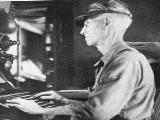 |
The beginning of the
Little Sioux Hustler is best told by quoting directly from the editorial
page of the first sheet, carefully preserved along with the succeeding 47
years of the of the paper, by the Onawa Library. First the masthead: the Little Sioux Hustler by the Revier Publishing company. H. W. Kerr, business manager; C. Nelson, managing editor. The demand for a periodical in which to expound the virtues of a bright, beautiful little village, high under the shelter of the hills, |
| which stands out so sublimely, as sentinels guarding, as it were, the waters of the bigh Muddy from encroaching prairies beyond, settled upon the banks of the Little Sioux River, not far from where she allows her placid water to mingle the turbulent waters of the great Missouri, surrounded by the fertile valley, who's soil produces tenfold.......could a birthplace be marked in a more fitting spot than Little Sioux. Could a name be more appropriate than: THE HUSTLER | |
1952 Flood
|
|
|
| The above pictures show the mud and water during the flood, it you look closely at the Tine Myers house, you will see a line in the middle of the windows, this is water! | |
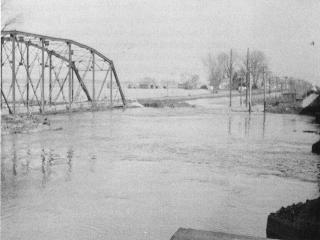 |
|
|
Little
Sioux River floods the bridge and railroad trestle |
|
I hope you have enjoyed your
visit, come back often. If you have questions
please contact me, if I don't know the answer I will try to get you in contact
with someone that will have the answers.
Little Sioux
Photo Album
|
|
Discover Iowa Genealogy WebRing |
Back to Harrison County
Other Little Sioux Links